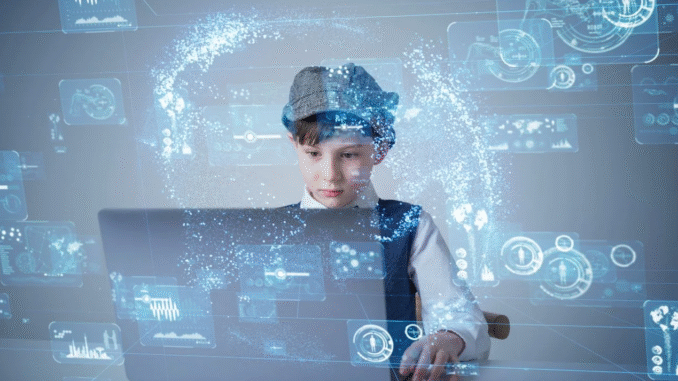
How Technology is Revolutionizing Traditional Education Methods in 2025
In 2025, the landscape of education is vastly different from what it looked like just a few years ago. Technology has fundamentally transformed traditional education methods, revolutionizing everything from how students access information to the tools educators use in the classroom. What was once confined to static textbooks and blackboards has evolved into a dynamic, interactive, and highly personalized learning environment.
As digital technologies continue to evolve, they bring both challenges and opportunities to traditional education systems. This article explores how technology is reshaping traditional education methods in 2025 and the lasting impact this transformation will have on the learning experience.
1. Personalized Learning Powered by AI
Artificial Intelligence (AI) is at the heart of many educational advancements in 2025. One of the most significant ways AI is revolutionizing education is by enabling personalized learning. In traditional educational settings, students often follow a one-size-fits-all approach, with teachers unable to tailor lessons to the individual needs of every student. However, AI-driven systems are now able to analyze a student’s performance in real-time, identify areas of struggle, and recommend personalized learning resources or strategies.
For instance, adaptive learning platforms powered by AI can adjust the difficulty of lessons based on a student’s performance. If a student excels in a particular subject, the system can present more challenging material. If a student struggles, the system can offer additional support and resources, ensuring that no student is left behind. This personalized approach not only enhances learning outcomes but also boosts student engagement and motivation.
Benefits: Personalized learning experiences, better academic performance, and increased student retention.
2. Virtual and Augmented Reality (VR/AR) for Immersive Learning
In 2025, Virtual Reality (VR) and Augmented Reality (AR) are no longer just experimental technologies but integral parts of the education system. VR and AR have completely transformed how students interact with educational content, providing immersive experiences that go beyond traditional textbooks or static images.
VR allows students to virtually visit historical landmarks, explore scientific phenomena, or dive into complex environments, like the human circulatory system, in ways that would have been impossible in the past. On the other hand, AR overlays digital content in real-world settings, providing interactive and engaging learning experiences.
For example, in a history lesson, students can virtually walk through ancient Rome, experiencing its culture, architecture, and daily life. In science, AR can help students visualize complex biological processes or molecular structures in 3D, allowing for a deeper understanding of abstract concepts.
Benefits: Engaged and motivated students, enhanced understanding of complex concepts, and opportunities for experiential learning.
3. Online Learning Platforms and Hybrid Classrooms
Online learning has exploded in popularity, particularly in the wake of the COVID-19 pandemic. By 2025, online learning platforms like Coursera, edX, and Khan Academy have matured, offering high-quality, interactive content that rivals traditional in-person classes. Students no longer need to attend physical schools to access top-tier educational resources. This shift towards online learning has made education more accessible to students worldwide, regardless of geographical location.
Moreover, hybrid classrooms have become a common educational model. These classrooms blend in-person and online learning to create a more flexible, student-centered approach. In a hybrid model, students can attend virtual lessons or complete assignments online while still having access to in-person activities, discussions, and mentorship. This flexibility allows students to learn at their own pace and according to their own preferences.
Benefits: Increased access to education, flexible learning schedules, and the ability to learn from anywhere.
4. Collaborative Learning and Social Learning Platforms
Technology has made collaborative learning more accessible than ever before. With the rise of social learning platforms like Google Classroom, Microsoft Teams, and Slack, students can now easily collaborate on projects, share ideas, and communicate in real-time—whether they are in the same room or on different continents.
These platforms allow students to work together on assignments, discuss topics, and give peer feedback in a seamless virtual environment. This not only enhances teamwork and communication skills but also encourages the sharing of knowledge, critical thinking, and collaborative problem-solving. Moreover, online discussion forums and communities provide an opportunity for students to interact with global peers, expanding their horizons and perspectives.
Benefits: Improved teamwork and communication skills, peer-to-peer learning, and exposure to diverse viewpoints.
5. Data Analytics and Learning Management Systems (LMS)
Data analytics has become a crucial part of the modern education system, helping educators understand student performance and adjust their teaching methods accordingly. Learning Management Systems (LMS) have evolved into powerful platforms that track a student’s progress, behavior, and engagement in real-time. Through analytics, educators can identify students who are at risk of falling behind and intervene before they face major challenges.
By 2025, most educational institutions use data-driven insights to create tailored learning plans, identify trends in student performance, and predict future learning outcomes. This data-driven approach helps educators make informed decisions and implement targeted interventions to improve student success rates.
Benefits: Data-driven decision-making, improved student support, and optimized learning strategies.
6. Gamification and Interactive Learning Tools
Gamification has emerged as a powerful strategy to make learning more engaging and enjoyable. By incorporating game-like elements such as points, badges, and leaderboards into the curriculum, educators can motivate students to achieve learning milestones while also enhancing their problem-solving and critical thinking skills.
Gamified learning platforms provide students with a fun, interactive experience that fosters healthy competition and self-improvement. These platforms often incorporate storylines and challenges that align with educational goals, making subjects like math, science, and literature feel like an adventure.
In 2025, gamification is a standard feature in many classrooms, helping students stay engaged while they work toward mastering new concepts. This trend is particularly effective in K-12 education, where students benefit from a more playful and interactive approach to learning.
Benefits: Increased student engagement, improved motivation, and enhanced problem-solving skills.
7. Automation and AI-Driven Administrative Tasks
While the focus is often on how technology enhances the learning experience for students, it’s equally important to recognize how it is transforming administrative tasks for educators and institutions. In 2025, automation powered by AI is making administrative processes more efficient than ever before.
AI systems can automate tasks such as grading, scheduling, and resource management, freeing up educators to focus more on teaching and mentoring. Additionally, chatbots and AI assistants are now commonly used to answer student queries, guide them through assignments, and provide personalized academic support outside of class hours.
Benefits: Reduced administrative burden on educators, increased efficiency, and more time for personalized student engagement.
8. Blockchain Technology for Credentialing and Security
Blockchain technology, known for powering cryptocurrencies, is increasingly being adopted in education to provide secure, verifiable digital credentials. By 2025, blockchain will be a trusted method for verifying academic qualifications, certificates, and diplomas, reducing the risk of fraud and ensuring transparency.
With blockchain, students can store their academic records securely, and employers or other educational institutions can easily verify these credentials. This also makes transferring credits between institutions or across borders simpler, as the blockchain ensures that records cannot be altered or tampered with.
Benefits: Enhanced security, transparent credentialing, and easier verification of academic qualifications.
9. Mobile Learning and Educational Apps
Mobile technology is one of the most significant drivers of change in education. By 2025, smartphones and tablets are essential learning tools, providing students with access to educational content at their fingertips. Educational apps, such as language learning platforms (e.g., Duolingo) and study aids (e.g., Quizlet), allow students to learn on-the-go, making education more flexible and accessible.
These apps support various forms of learning, from self-paced lessons to interactive quizzes and simulations, allowing students to learn and review material outside of the traditional classroom environment.
Benefits: Flexibility in learning, access to resources anywhere, and improved mobile literacy.
10. Sustainability and Green Education Initiatives
In 2025, there is a growing emphasis on integrating sustainability into the curriculum. Educational institutions are increasingly adopting green practices, such as using renewable energy, reducing waste, and promoting sustainability in their courses and research. Technology is playing a crucial role in this transition, with tools that help students understand the importance of sustainability, environmental responsibility, and green technologies.
Benefits: Increased environmental awareness, preparation for green jobs, and a focus on sustainable practices.
Conclusion
As we look ahead to 2025, technology continues to redefine traditional education methods, offering unprecedented opportunities for students and educators alike. From AI-powered personalized learning to immersive VR experiences, the ways in which students learn and engage with content are evolving rapidly. While there are challenges, such as digital inequality and the need for teacher training, the overall impact of technology on education is overwhelmingly positive. As these innovations continue to shape the future, it’s clear that technology will remain an essential tool in fostering accessible, engaging, and personalized learning experiences for students worldwide.

